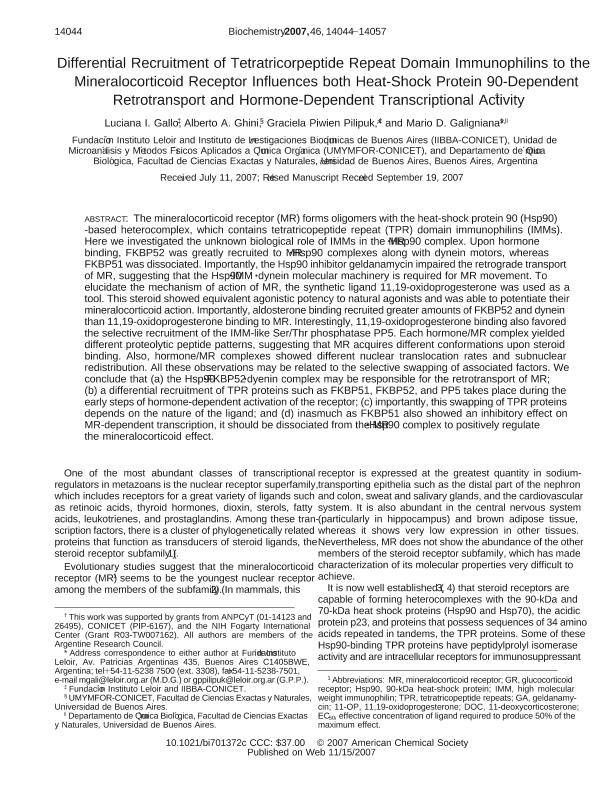Artículo
Differential Recruitment of Tetratricorpeptide Repeat Domain Immunophilins to the Mineralocorticoid Receptor Influences both Heat-Shock Protein 90-Dependent Retrotransport and Hormone-Dependent Transcriptional Activity
Fecha de publicación:
11/2007
Editorial:
American Chemical Society
Revista:
Biochemistry
ISSN:
0006-2960
Idioma:
Inglés
Tipo de recurso:
Artículo publicado
Clasificación temática:
Resumen
The mineralocorticoid receptor (MR) forms oligomers with the heat-shock protein 90 (Hsp90) -based heterocomplex, which contains tetratricopeptide repeat (TPR) domain immunophilins (IMMs). Here we investigated the unknown biological role of IMMs in the MR·Hsp90 complex. Upon hormone binding, FKBP52 was greatly recruited to MR·Hsp90 complexes along with dynein motors, whereas FKBP51 was dissociated. Importantly, the Hsp90 inhibitor geldanamycin impaired the retrograde transport of MR, suggesting that the Hsp90·IMM·dynein molecular machinery is required for MR movement. To elucidate the mechanism of action of MR, the synthetic ligand 11,19-oxidoprogesterone was used as a tool. This steroid showed equivalent agonistic potency to natural agonists and was able to potentiate their mineralocorticoid action. Importantly, aldosterone binding recruited greater amounts of FKBP52 and dynein than 11,19-oxidoprogesterone binding to MR. Interestingly, 11,19-oxidoprogesterone binding also favored the selective recruitment of the IMM-like Ser/Thr phosphatase PP5. Each hormone/MR complex yielded different proteolytic peptide patterns, suggesting that MR acquires different conformations upon steroid binding. Also, hormone/MR complexes showed different nuclear translocation rates and subnuclear redistribution. All these observations may be related to the selective swapping of associated factors. We conclude that (a) the Hsp90·FKBP52·dyenin complex may be responsible for the retrotransport of MR; (b) a differential recruitment of TPR proteins such as FKBP51, FKBP52, and PP5 takes place during the early steps of hormone-dependent activation of the receptor; (c) importantly, this swapping of TPR proteins depends on the nature of the ligand; and (d) inasmuch as FKBP51 also showed an inhibitory effect on MR-dependent transcription, it should be dissociated from the MR·Hsp90 complex to positively regulate the mineralocorticoid effect.
Palabras clave:
Hsp90
,
Mineralocorticoid Receptor
,
Immunophilins
Archivos asociados
Licencia
Identificadores
Colecciones
Articulos(IBYME)
Articulos de INST.DE BIOLOGIA Y MEDICINA EXPERIMENTAL (I)
Articulos de INST.DE BIOLOGIA Y MEDICINA EXPERIMENTAL (I)
Articulos(IIBBA)
Articulos de INST.DE INVEST.BIOQUIMICAS DE BS.AS(I)
Articulos de INST.DE INVEST.BIOQUIMICAS DE BS.AS(I)
Articulos(UMYMFOR)
Articulos de UNID.MICROANAL.Y MET.FISICOS EN QUIM.ORG.(I)
Articulos de UNID.MICROANAL.Y MET.FISICOS EN QUIM.ORG.(I)
Citación
Gallo, Luciana Ines; Ghini, Alberto Antonio; Piwien Pilipuk, Graciela; Galigniana, Mario Daniel; Differential Recruitment of Tetratricorpeptide Repeat Domain Immunophilins to the Mineralocorticoid Receptor Influences both Heat-Shock Protein 90-Dependent Retrotransport and Hormone-Dependent Transcriptional Activity; American Chemical Society; Biochemistry; 46; 49; 11-2007; 14044-14057
Compartir
Altmétricas




